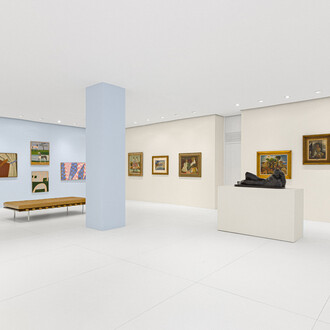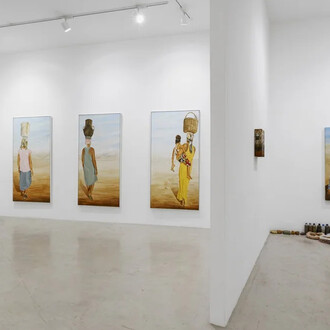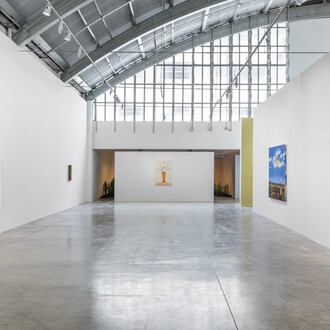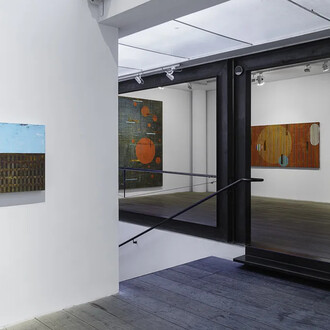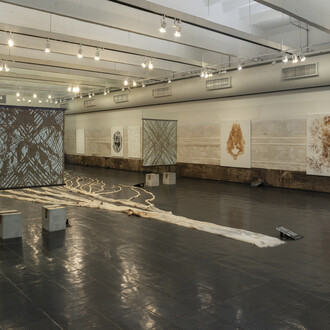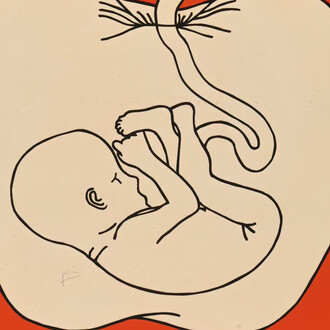Casa Triângulo is pleased to present Todos os Lugares, the seventh solo show by Alex Cerveny.
The exhibition features more than one hundred drawings and paintings on paper, linen, parchment and aramid (a very light and strong synthetic fiber). In contrast to the spaciousness of the gallery, the exhibition features a selection of artworks chosen for the quality of their lines, and which, therefore, should be seen from close-up. This group of never-before-shown drawings and paintings provides a look at the artist’s extensive period of production, including a watercolor from 1999 counterposed to two more recent paintings by the artist in which one reads “Tanto importa o não ser, como haver sido” [Not being matters as much as having been], a line from the poem Ao dia do juízo [To the Judgment Day] by Bahian poet Gregório de Mattos (1639–1696). The selection of works sheds light on the artist’s ability to strike a balance between coherence and diversity over time.
Concerning the work of Alex Cerveny, Renato Rezende observes: “Anchored in a distinguished and patient technique, his work perfectly comprehends and constitutes a shrewd and compassionate commentary on the complexity and ridiculous sublimity of the contemporary world, and yet is able to transubstantiate it in narratives full of spirituality, meaning and humanity.”
The key work, a poetic axis of the entire exhibition, is presented in an alphabet of capital letters created for the book Todos os lugares [All the Places] that the artist is releasing later this year through Circuito publishers. Each letter possesses in its design a speculation about the male body in minutely detailed watercolors.
Other highlights of the show are the never-before-shown painting José interpretando os sonhos do faraó [Joseph Interpreting the Dreams of the Pharaoh] and a hunting scene in the ancestral forest of Jacarepaguá. In the former, the biblical theme and the reference to psychoanalysis become secondary in light of the oneiric overflowing that it offers. Alex spent seven years working on this canvas that shows a “time capsule” honoring a long list of names of actors such as Rainer Werner Fassbinder and Pier Paolo Pasolini, along with Brazilian actors, among suggested landscapes. It is an artwork that conveys like few others the artist’s narrative drive. In the latter, a precious 30-cm altar, the choice of the artwork’s support – panels of aramid for the making of a bulletproof vest – talks about the naturalization of the state of violence in which we live.
Besides the original works of a poetic essence, Alex is presenting illustrations for a book of short stories by Valter Hugo Mãe; for On the Origin of Species, by Charles Darwin; and for a novel by José Eduardo Agualusa, recent editorial collaborations.
Alex Cerveny was born in 1963, in São Paulo, where he lives and works. His solo shows in recent years have most notably included Palimpsesto, a retrospective of his graphic work at Museu Lasar Segall, São Paulo, Brazil (2019); Glossário dos Nomes Próprios, Paço Imperial, Rio de Janeiro, Brazil (2015); Casa Triângulo, São Paulo, Brazil (2015) and the III Mostra do Programa de Exposições, Centro Cultural São Paulo, São Paulo, Brazil (2012). Group shows in which he has participated in recent years include: Nous Les Arbres na Fundação Cartier, Paris, France (2019); Da Tradição à Experimentação, Fundação Iberê Camargo, Porto Alegre, Brazil (2019); Queermuseu - cartografias da diferença na arte brasileira, Parque Lage, Rio de Janeiro, Brazil (2018); Homo Ludens, curated by Ricardo Sardenberg, Galeria Luisa Strina, São Paulo, Brazil (2016); Os Muitos e o Um, curated by Robert Storr, Instituto Tomie Ohtake, São Paulo, Brazil (2016); Clube de Gravuras: 30 Anos, curated by Cauê Alves, Museu de Arte Moderna, São Paulo, Brazil (2016); En y entre geografias, Museo de Arte Moderno de Medellín, curated by Emiliano Valdes, Medellín, Colombia (2015); Figura Humana, curated by Raphael Fonseca, Caixa Cultural, Rio de Janeiro, Brazil (2014); 30th Bienal de Artes Gráficas de Ljubljana, Ljubljana, Slovenia (2013); and Trienal Poli/Gráfica de San Juan, San Juan, Puerto Rico (2012). In 2012, he received the Prêmio Marcantonio Vilaça from the Fundação Nacional de Artes (Funarte) for the 64 originals in cliché-verre in the book Pinóquio, a história de um boneco, released by Cosac Naify publishers in the previous year. In 2016, he was one of the winners of the Prêmio ProAC Livro de Artista with the project O desenho visto do céu, a photographic and literary report on the expeditions to the Nazca Lines in which he participated between 2005 and 2011 together with the team of the Maria Reiche Association of the University of Applied sciences (HTW) of Dresden, Germany.









